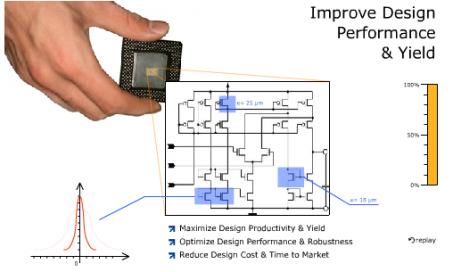How do I know if an AMS block is tuned for the process and will perform and yield acceptably?
Historically there have been two major approaches to transistor-level circuit optimization of analog blocks:
[LIST=1]
If you are an EDA company that has a SPICE circuit simulator then you tend to promote option number one because you can sell more SPICE simulators.
If you love mathematics then option number two is the most appealing approach because of it’s elegance in using equations instead of the more brute-force simulation-based approach.
The engineers at MunEDA use approach number one, simulation-based optimization with any SPICE circuit simulator.
News came out this week that MunEDA and Magma have cooperated to ensure that the combination of WiCkeD (MunEDA) and FineSIM SPICE (Magma) work well together.


Joint customers wanted to use MunEDA and Magma FineSIM SPICE tools together without writing their own scripts and doing CAD QA on point tools.
I spoke with KT Moore of Magma today by phone to get an update on this announcement.

Questions and Answers
Q: Who would use WiCkeD and FineSIM SPICE together?
A: Analog chip designers that need to optimize for performance and yield.
Q: How closely are the tools integrated?
A: WiCkeD creates a SPICE netlist for FineSIM SPICE and reads the simulation results as it optimizes a design. All the integration work was done at MunEDA, so Magma supplies the standard FineSim SPICE tool.
Q: What is the capacity for an analog design to be optimized?
A: From afew hundred to a few thousand devices are typically optimized.
Q: Can you comment on the Synopsys acquisition of Magma?
A: No, I’m sorry but I’m not at liberty to say.
Q: Why not use FineSIM Pro for circuit optimization instead of FineSIM SPICE?
A: Customer interest was strong with FineSIM SPICE compared to FineSIM Pro. These are analog designers that demand the highest accuracy, so it makes most sense to use FineSIM SPICE.
Q: Why should I use FineSIM SPICE and WiCkeD instead of some other circuit simulator?
A: For analog optimization the multi-cpu capability in FineSIM SPICE is scalable, so you can add more CPUs to improve your run times. This combination also scales for larger circuits, so you can optimize even larger analog netlists verus other SPICE tools.

Summary
Long gone are the old ways of simulating an analog design, measuring results, tweaking transistor sizes, then repeating until specs are met. Today you have to consider using an automated approach to optimize your analog design like the simulation-based optimization approach from MunEDA and Magma.







Quantum Computing Technologies and Challenges